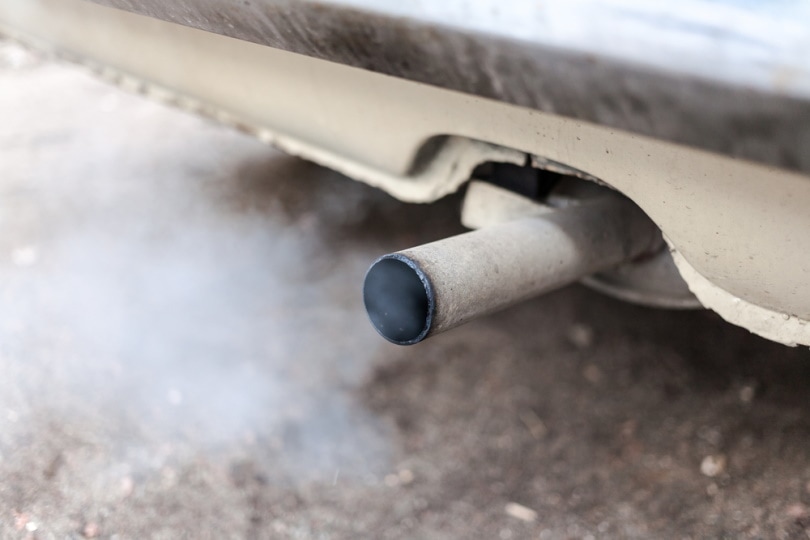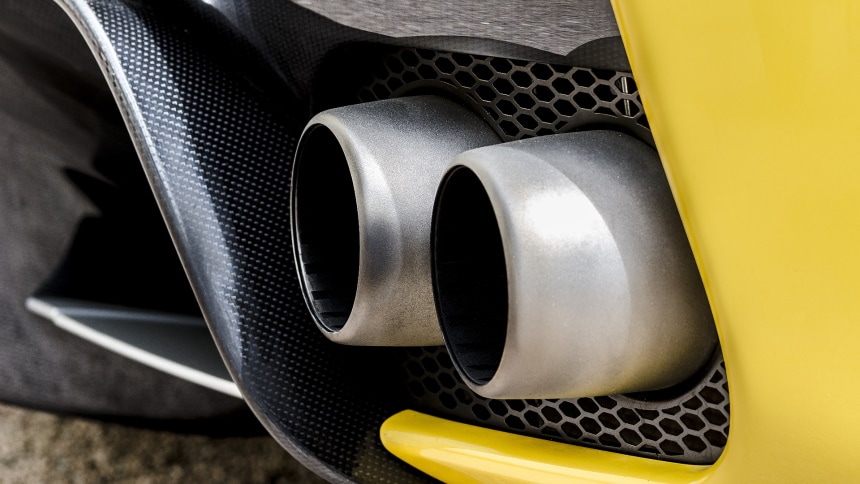How Hot Does a Car Exhaust Get? Temperature & Factors
-
Pete Ortiz
- Last updated:

The car exhaust system is a critical component of the car. It vents toxic gases away from the car cabin, ensuring the safety of occupants, while also minimizing or eliminating emissions, reducing engine noise and vibrations, and improving performance and fuel efficiency. Although it is a deceptively simple design, the exhaust system naturally gets hot and, if there are any problems with any of its components, overheating is one of the main symptoms.
The exact temperature that an exhaust reaches depends on various factors including the make and model of the car, how the car is being driven, and ambient environmental conditions, but the temperature can range from 600°F–1,800°F.
About the Exhaust System
Combustion engines produce lots of heat, gases, and noise, and it is the vital job of the exhaust system to eliminate or minimize these by-products. Through a series of chambers, pipes, gaskets, and other components, the exhaust vents hot gases away from the engine, converts noxious gases into inert gases and then expels them away from the car through the tailpipe. Before doing so, it gets rid of emissions that might cause damage to the environment and also dampens the vibrations and noises that come from the engine via the muffler. The exhaust has a lot of work to do, and in doing so, it does get very hot.

Typical Temperatures
The exhaust system is a long series of pipes and chambers, and the temperature it reaches depends initially on the distance of the component from the main engine.
- At the manifold, where the exhaust funnels gases directly from the engine, and at the bends of the exhaust pipe where it passes the engine cylinders, the temperature is at its hottest. Temperatures here can reach 1,200°F, especially if you are pushing the car and accelerating hard. Some performance cars may reach even higher temperatures than this, potentially exceeding 1,500°F.
- The catalytic converter takes toxic gases and converts them into inert gases that are safer. The cat contains precious metals like copper and iron, as well as rhodium, platinum, and palladium. These react with gases like carbon monoxide, and the chemical reactions that take place cause a thermic reaction. Temperatures can reach 1,000°F.
- The muffler is one of the last sections of the exhaust and is where noise and vibrations are reduced. Although this is one of the furthest sections from the engine, temperatures do still remain high, and you should expect the muffler to achieve temperatures of around 500°F.
- The tail pipe is the final piece of the exhaust system. By the time the gases reach this point, they have been converted to inert gases, emissions have been removed, and the temperature has cooled. This area of the exhaust is also exposed to outside air. Temperatures here are around 500°F.

What Affects Exhaust Temperature?
There are a lot of factors that determine exactly how hot an exhaust is other than which component of the exhaust you’re measuring.
- Exhaust and Engine Condition – The exhaust takes gases from the engine and is connected to the engine. As such, its temperature is directly correlated to that of the engine itself. If the engine is in good working order and running efficiently, the temperature should be well controlled. If the engine is damaged, and especially if it is having to work harder when being driven, because of that damage, it causes temperatures throughout the car to rise. Similarly, exhaust condition also determines how hot the system gets, and one of the main symptoms of a damaged exhaust is overheating. In these cases, the exhaust can reach temperatures of 2,000°F, and it can cause irreparable damage to the car while preventing the exhaust from doing its job.
- Engine Speed – This doesn’t necessarily represent the speed of the car, but the more revs an engine produces, the harder it is working and the hotter it gets. This means that the cylinders are hotter, and the gases the engine produces are also hotter. The end result is that the temperature of the exhaust rises. When a car is idling, it is not working as hard, and the exhaust temperature is much lower, although still hot.
- Exhaust Design – Generally, heat is lost from the exhaust gases the further it has to travel. This means that exhaust systems with longer pipes tend to lead to a cooler tailpipe temperature. The diameter of the pipe also matters because the gas molecules have more room and time to move, which means that temperatures also drop.
Overheating Exhaust
An overheating exhaust is often a sign of a damaged or failing exhaust and it needs attention to ensure that gases are being properly exhausted. If the system gets too hot, it can cause a serious problem, so even a small crack can quickly become a major and expensive repair. If you believe that your exhaust is running hot, take it to a mechanic to have it checked and determine the problem.
In Conclusion
The exhaust system is a critical component in your car. Engine gases are passed through a series of pipes and chambers, which causes the exhaust system to get hot. Although the exact temperature varies according to which part of the exhaust and can be affected by factors like engine and exhaust condition and how much load the engine is operating under, you can expect temperatures to range from around 600°F–900°F in most cars and most cases, although temperatures up to 1,200°F are normal and shouldn’t be a cause for concern.
Featured Image Credit: Alexander Ishchenko, Shutterstock
Contents


